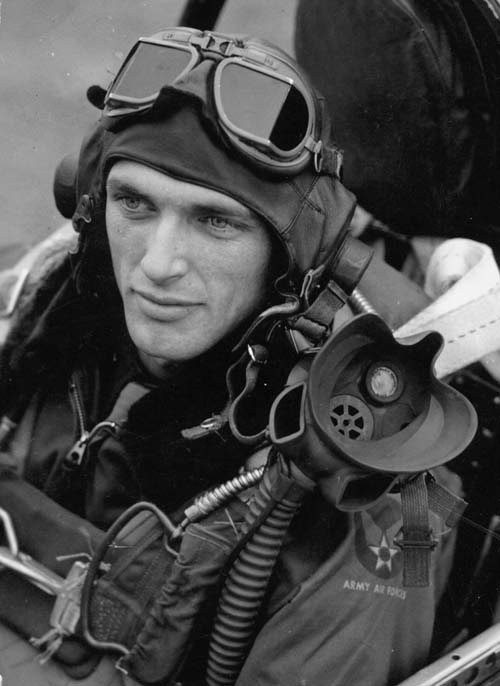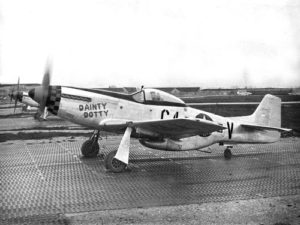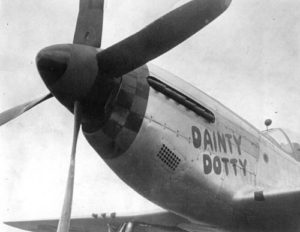
Jim McLane in the cockpit of his Mustang
“Shooting down the Squadron Commander is no way to make a name for yourself even if you are running behind.” By Jim McLane
No doubt about it, the Great War was winding down. I’d been busting my butt for 2 years 10 months, and 17 days trying to get into the action, and there had been nothing but frustration and delay at almost every turn. But at long last I’d arrived at the Air Corps replacement Center at Stone, England, and my goal seemed to be in easy reach. A week later, after becoming fully acclimated to the miserable late winter British weather, I joined 11 other pilot replacements and reported to the Leiston encampment of the 357th Fighter Group. It was March 24, the day that the army airborne crossed the river Rhine. Nobody could foresee the future, of course, but the 357th was celebrating its last really big day, having shot down 16 enemy aircraft and destroyed 4 more on the ground while on patrol. this was a clear and present sign to the newcomers that opportunity was still knocking. I fully expected to be heading across the channel in just a few more days to meet the enemy above his home turf. What a letdown it was to learn that several more weeks of training in Captain Bochkay’s “Clobber College” were necessary before I’d be trusted to confront the Boche! Along with Johnny Metcalf and G. A. Robinson’s little brother Joe, I’d been assigned to the 362nd squadron. the day finally came when Captain Chuck Weaver, the ops officer, gave me the choice of flying the next day’s mission or taking a three day pass to London. That was about the easiest decision I’d ever made!
Thus I joined 63 fellow birdmen of the 357th and the crews of perhaps 950 other 8th Air Force bomber and fighter planes on Tuesday, April 17 intent on doing away with the Aussig Chemical Works somewhere in Germany. (Or maybe it was Czechoslovakia. During my four forays into the heart of the Evil Empire I never knew for sure where we were; after all, wingmen weren’t issued maps.) It was a classic 1000 plane daylight raid in near-perfect weather, just as we’d seen in the Pathe Movietone newsreels, only in living color and better focus. All of the expected elements of high drama were there: strings of bomber formations stretching box after box across the sky, swarms of fighter planes maneuvering over the bombers as if daring the Luftwaffe fighters to approach, black puffs of exploding enemy flack each containing a surprising momentary bright red flash that hadn’t been captured in the black and white newsreel pictures, more bright red flashes far below as the bombs exploded, excited voices in the earphones of my leather British flight helmet tolling the count of parachutes from a B-17 which was headed for the ground some 4 miles below at an angle of descent never intended for that majestic flying machine. From the three bombers that exploded in front of my wide eyes, I saw only three open ‘chutes, and one of them caught on fire. There were German fighters, too. In sharp, clipped transmissions on the VHF radio my fellow warriors reported spotting them and even giving chase, but all I saw were a few jet contrails that looked to be higher that an airplane could possibly fly.
So why wasn’t I bursting with joy to find myself at long last in the midst of this Grand Spectacle? The answer came as if I’d never thought of it before: people are being killed here! I’d been witness to the demise of a number of friends in training accidents back home, but this was different. It was all so …on purpose! Looking around at all there was to see, my thoughts drifted to the single-minded efforts I’d made to arrive at this particular place at this instance in time. Then, as now, it didn’t seem cowardly to wonder whether I had been right in fighting against assignments that would have kept me in the USA near my pregnant wife, and far form this newly observed carnage. But of course it was a little late for that. There were also a couple of petty annoyances during the 5 hour 45 minute mission that took the edge off my elation. First, the extra equipment like the shoulder holstered 45 caliber automatic pistol and the inflatable G-suit worn for the first time felt strange and uncomfortable., But mainly, there was the matter of a loosened rubber trim tab control rod. We’d flown nothing but “B” and “C” model ’51s in the 20 hour Clobber College transition period. this was my first go at a fully equipped “D” model carrying 2 full 108 gallon paper drop tanks. Not knowing what to expect in the way of different flying characteristics, it took a while to conclude that something must be wrong to have caused the rudder trim tab control knob to have no effect on rudder trim. I’d had a hard time preventing the plane from veering sharply left during the takeoff roll. By the time we reached cruising altitude, my right leg was bordering on muscle cramp from holding right rudder. Finally, I rolled in enough aileron trim to counteract the offset rudder so the plane would fly straight ahead on its own (actually, sideways ahead on a steady course with its right wing down). I thought about the difficulty in aligning the platform if there was cause to fire the six 50-caliber machine guns which, after all was the excuse for my being there. Well, that just didn’t happen. the long flight came to an inglorious end when I misjudged spacing from Lt. Cheever, my flight leader, in the pattern and had to go around for a second try at landing. To top off the emotional binge of that first day, upon return to the Squadron Operations building for debriefing, I was caught unawares and royally chewed out by the conscientious sergeant in charge of personal flying equipment. He noticed that I was wearing a pair of Gaucho boots instead of regulation GI high top shoes. My father had sent the boots to me from Brazil where he was construction air fields and I prized them greatly. having been caught flat-footed, I suffered through a ten minute lecture in which it was pointed out that the loosely bound boot would probably fly off instantly if I had to bail our, and I any case would not serve as well as the GI shoes for walking out from behind enemy lines. Given all the food for thought, it was surprising that a few hours of sleep were all it took to reset every thing for a fresh new start the next day.
It’s amazing what one day of experience on a new job can do to build confidence! After a good breakfast we were briefed for a new kind of mission that caused me to put aside all thought of the downers from the previous day. the enemy had been scrambling their ME262 jet fighters just in advance of the stream of invading American heavy bombers. They would climb quickly to an altitude of 30 to 40 thousand feet, well above the effective fighting ceiling of our P-51s. then when the bombers arrived each ME262 would make a very fast diving pass through a box of bombers, seldom failing to knock down one or more. Because of the limited fuel capacity of the German jet, there was usually no second pass and a good many were destroyed as they sought to land with low fuel remaining. Some strategist reasoned that our P-51s might be able to catch the speedier ME262s right after takeoff before they really got going if we arrived over their airdromes at the right time. The selected airfields for this raid were near Prague, and each unit of the 357th was assigned responsibility to watch over activity at a particular field. Major Kit Carson, our Squadron Commander, was to lead the group and I was to be his wingman., I carefully laced an double-tied my high topped GI shoes before riding out to the hardstand for a quick walk-around inspection of the airplane. My main concern, of course, was with checking the safety-wired locknut on the rudder trim tab control rod. In due course it was time to start engines, and to fall in behind Kit Carson’s legendary “Nooky Booky” leading the pack to takeoff position.

“Dainty Dotty” G4-V, 44-14798, Aircraft from Bertram. Named for Jim’s wife Dorothy
At times, when the weather borders on perfection, the exhilaration of flying has become almost a religious experience for me. I had the feeling at midday on Wednesday, April 18, 1945, as the fields of east Germany some 13 thousand feet below spread their greenery in panoramic Spring splendor before me and my wonderful machine. Of course I didn’t know exactly where we were, but according to the notes from the morning briefing on the small clipboard strapped to my knee it was about time for us to arrive at our destination. Major Carson, who was not noted for long winded speeches on the radio, had not broadcast a work since we started engines at Leiston. Suddenly, to my surprise and still without saying anything, he pitched directly over – sort of a 1/4 outside loop – until he was in a vertical dive. Miraculously I was looking right at him when he started this maneuver, and somehow managed to stay with him, albeit trailing a bit behind. Had I been looking away for a few seconds, I probably would never have caught up with him. As it was, the second half of Dollar Red flight by G. A. Robinson had missed the initial pushover, and was already far behind. Again without announcement, Carson’s two drop tanks flew off (it was a clean miss, slightly off to my left), so I figured that I’d better drop mine, too. Even though I still didn’t know what we were doing, it was obvious that he was on to something, and I will admit to letting the excitement build within me. I reached for the switch that armed the bomb shackle circuits so that the little button on top of the control stick could be used to drop the tanks, and then squeezed the button hard. The plane shuddered, and a faraway staccato sound reached my ears. The voice of G. A. Robinson, now watching from a good way away, came through to me 5 x 5, “GO GET’EM, MAC!” Suddenly, it all made sense. The airframe shudder, the staccato sound, G. A.’s exhortation, and the realization that my fist was rigidly encircling not only the small button on top of the stick, but the gun trigger on its front as well could only mean that I had loosed the armor-piercing outpour of 6 50-caliber machine guns on a piece of airspace very close to the Squadron Commander! It seemed apparent that I had missed him, and thank goodness the use of tracers had been abandoned some time back, so he didn’t get to see all the lead go by. My main worry now was what would appear on the gun camera film, but that would have to wait until later. Apparently in the excitement and haste to arm the bomb shackles, I flipped on the adjacent gun arming switch as well, permitting the guns to fire when the trigger was accidentally squeezed. G. A. had seen something that I couldn’t – the smoke from the 6 firing guns.
Now that it seemed like that Major Carson had survived my attack, it was time to turn attention to other things like trying to figure out what we were doing. Still going straight down, full throttle and matching RPM were required for me to stay up with him. The airspeed quickly built and soon passed the redline mark on the dial. I resolved not to worry about that , instead, when his wings flew off, I would throttle back. About this time I noticed that we were diving on an airfield, in all likelihood the one we’d been assigned to. Eventually, I was even able to spot the ME262 in its takeoff roll that had attracted Carson’s attention from on high. We swooped in behind soon after it cleared the airport boundary. At about 1000′ altitude, we were traveling about as fast as the P-51s could, but the ME262 was clearly pulling away. Carson fired on him from marginal gun range, and got a couple of hits but soon he was gone.
We climbed back to about 5000′ and circled near the airfield, hoping that another ME262 would venture out. Since now there were only the two of us I spread out to the side enough to turn into my companion in case some Jerry showed bad enough judgment to approach us from behind. Soon we spotted another jet and gave chase at about 700′. Carson fired on him without visible effect as he was still a bit our of range. I concluded that it would do no harm for me to lob a few 50 caliber slugs in his direction, so I did, being careful to allow for the extreme range. There weren’t any bright flashes, and in fact he was so far away that his tail-on image is missing from the gun camera film, one of life’s great disappointments for me. The surprising thing was that while we weren’t gaining on the jet, neither did we seem to be losing ground. Shortly, the German began a wide turn to the left that made my heart pound, for now I knew we had him. All we had to do was cut him off in the turn to get within firing range. Strangely, my leader adopted the exact opposite tactic, and pulled wide to the outside of the turn. Using logic that is available only to the pathologically obsessed I quickly deduced the reason for this unusual maneuver; Major Carson was going to let me have this one. After all, he’d been credited with over twenty victories, surely enough for any one pilot, and he knew that the war was about to end on me without my having fired a shot at even one. So he was giving me my big chance! What a guy! I pushed again on the fire walled throttle and started lining things up in the gun sight as my adversary came out of his wide turn and resumed straight flight, still a bit out of range. Suddenly, a virtual blanket of small white small white puffs of smoke appeared to form just above my flight path, and it became obvious that the Crafty Kraut had led me directly over the light flak batteries situated around his airfield. Of course, Major Carson had seen the airfield and was not fooled into following the jet as I was. The German advance his throttle and was gone to parts unknown as soon as the flak started.
Given the apparent density of the “golf-ball” canopy I’d penetrated, I concluded that the airplane must have been hit in several places, even though everything appeared to be working properly. Since the e P-51 was particularly vulnerable to breaks in the oil and coolant lines that extended from the engine to the radiators, I maintained a close vigil on the instruments that would disclose such a problem. I also made up my mind to belly in rather than bail out if the engine failed, and kept picking out satisfactory fields ahead to do this in. For the last 18 months I’d had a recurring dream about ditching, and felt that this was practice enough to belly in with confidence. Finally I noticed that my fuel remaining was down to the minimum value to return home and called Major Carson to tell him so. This unnecessary and ridiculous call inspired him to break radio silence for the first time that day to tell me that we had been on our way home for the last 20 minutes.
Back at Leiston, the crew chief was happy to see that the guns had been fired; I didn’t bother mentioning that the red muzzle tapes were broken first when I almost shot down the Squadron Commander. I apologized for all the flak holes he would surely find in his airplane, but a careful inspection showed the apology to be unnecessary. I viewed the blank gun camera film with mixed emotions: great relief when “Nooky Booky” turned out to be completely out of the camera’s field of view, but lifelong disappointment when the ME262 I’d shot at could not be seen. I flew two more missions before being ordered to take that pass to London which marked the end of the Great War for me. But it is this day that lives most vividly in my memory 48 years later; the day I first fired my guns in combat – at the Squadron Commander. Was it worth the many months of preparations? You bet it was!
Footnote: After the war, Kit Carson and I, and our wives, became good family friends while working for the NACA at Langley Field, and later at the Air Force Arnold Engineering Development Center in Tennessee. He never knew about this particular close call until I told him one night over drinks and dinner during a visit to California in 1980. For another version of this mission to the airfields at Prague see Carson’s book, Pursue and Destroy, pages 122 & 123.


